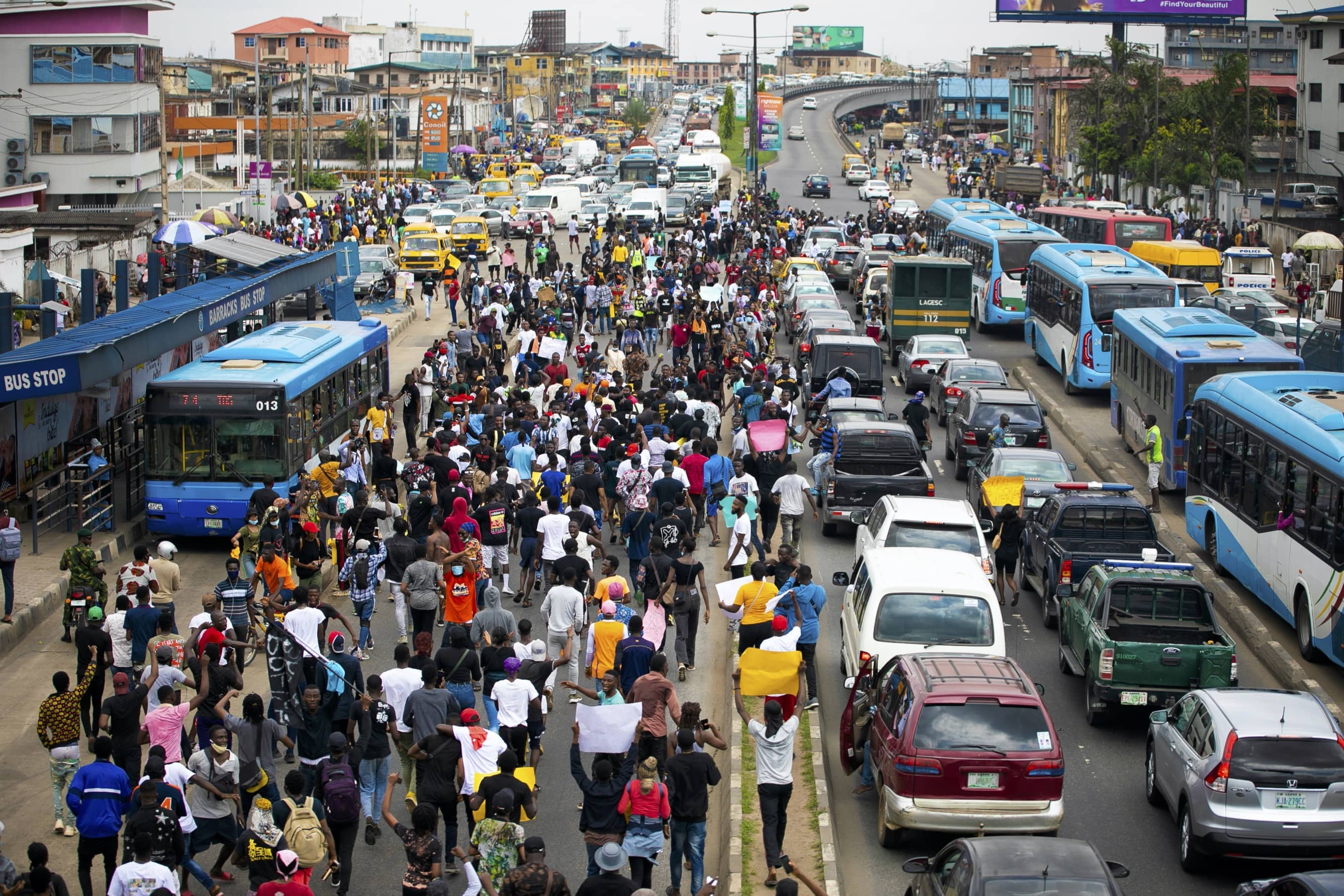
www.buildingsandcities.org/insights/commentaries/decolonialising-urban-planning.html
Decolonialising Urban Planning

Applying lessons from indigenous urban planning can make Nigerian cities more sustainable
Mokọ́ládé Johnson (University of Lagos) explains why Nigerian cities have lost their vernacular approaches to urban planning and the resulting negative impacts that arise. Could former indigenous urban design principles be adapted to inform contemporary urban planning practices?
How has urban planning in Nigeria changed?
In pre-colonial times, Nigerian settlements tended to be planned around footpaths and walkways as the main mode of transport of its citizens and goods. This situation is no longer prevails. Cities are larger in scale, and services are no longer with walking distance. Mass-transit buses, trains, and highways are needed to link city neighbourhoods and services. Streets have had to adapt to accommodate automobiles, leaving little or no room for pedestrians. This negatively impacts on the health of citizens by reducing opportunities for walking and causing air pollution. However, fast urbanising metropolises like Lagos are comprised of urban villages. The opportunity exists to reintegrate walking into urban designs to promote healthier lifestyles.
In Nigeria, typical indigenous settlement and city forms are composed of tangible and intangible layers and materiality with blurred boundaries. For instance, overlaying a religious layer on the physical city often reveals a faded vernacular template at the home, neighbourhood, city, and regional scales. Ancestral schools of thought claim that the physical plans of Yorùbá cities can be either circular or elliptical or squarish. Yet all agree that the centre of the city is sacred and the site of socio-political power, a domain for the king and the administrative hierarchy of society. Traditionally, surrounding the centre are found verdant parcels of religious, agricultural, and productive landscape. This approach ensures those in power are at the geographic and political centre of the population, but this also has environmental benefits. For instance, locating agriculture adjacent to the urban centre means these green spaces help to mitigate the extremes of the hot-humid tropical climate in the city.
In Yorùbá, Nigeria, public realms are a blend of allotted backyard farms, agricultural lands, sacred groves, courtyard-houses, native-tree planted neighbourhoods, open space markets, and people-centred governance structures in cultural hierarchies. There is a cultural belief that no matter how big the city is, the voice of the deity must echo in every neighbourhood. However, these vernacular patterns, and planning principles are now lost to inherited or imposed colonial architecture and design doctrines in today's postcolonial cities in Nigeria. However, although these traditional features are now no longer part of contemporary urban planning principles, there remains a shadow of them that are still legible in Nigerian cities, though they are fading in the face of modernisation and urbanisation.
Economic development and demographic transition
Changes to Nigeria's economy have shaped its urban design. Forced slavery in Nigeria in the 1800s not only created profound cultural shock, it also imported new construction methods, materials and designs. More recently, the 2008 economic meltdown triggered a switch in decision-making to favour cheaper alternative options across all areas of urban development. New rail transport links between cities were downgraded from costly high speed options. There was also a move to using mass-produced construction materials, which often lead to designs emulating examples from the Global North, rather than traditional approaches.
Thus, shifts in economies have eroded tenets of cultural significance in Nigeria, which further accelerated the adoption of modern approaches and the loss of vernacular principles. But at what cost? Vernacularity holds agency over modern urban planning approaches when considering sustainability performance benefits. Indigeneity in a Nigerian urban context promotes organic cities, while more modern development tends to result in a reduction of green infrastructure in cities, and with it, a loss of the wellbeing, health and ecosystem services that these spaces can bring. Traditional planning metaphors created positive sustainable urban architecture in the past, but can reverting to such local heritage-identities that define homegrown realms, promote more sustainable cities today?
Fast urbanisation and industrialisation have turned the cities into economic engine rooms for the world today. Cities are projected to house over 75% of global populations before the end of the 21st century. As such, demographics play a significant role in urban development. Many postcolonial cities of the Global South assimilated Western ideas which had detrimental implications for urban spaces: the loss of sacred, agricultural, green and communal spaces.
The absorption of people from the countryside into the city had profound impacts on urban planning, taking cities today even further from their ancestral design. It has also affected the lives of citizens. Many Nigerians now live a dual way of life caught between "village" life and bustling "city" life. This duality is manifest both in the psychological and physical sense as the home in the village is more culturally significant than the city's. This results in people travelling across multiple urban zones in their daily life, and the continued pursuit of Eurocentric or foreign templates for infrastructural and urban policy agendas. This approach fails to address fundamental challenges and opportunities at different layers of urban growth.
Traditional culture and modern urban design
The struggle to maintain an ancestral family home in a village and a house in the city to be near employment is counter to the traditional Nigerian metaphor in life and death. When a person is alive, they work in the city and go to the village periodically to strengthen cultural and kinship ties. At the time of death, their body goes home for burial in the village as the final resting place. This suggests that the "city" can exist successfully where it is able to work harmoniously with the concept of the "village" and so traditional urban design concepts could help citizens balance culture and economic development in a modern world.
There are many indigenous ideas that informed all scales of urban design and planning from the house, to communities and regions. For instance, residential design around the indigenous courtyard system, creating social space at community level, and respect for central spaces for the civic realms. The historical incidences that led to the relegation of such indigenous competences and values need to be reconsidered. Older design doctrines are people-centred with participation via traditional tenets for enduring heritage. Reconnecting with these has potential to produce blended principles for replanning and refurbishing old city parts and the design of new suburban areas. We need to apply a mix of the best of the old methods and the best of modern practises, and much of the traditionally viable low-tech know-how could be scalable in today's technologically-driven urban villages.
Clearly, past decision-makers and city planners could not envisage the myriad challenges that modern cities face today, but historic designs could provide some principles for planning our urban spaces more sustainably. It is not clear that current trends in Nigeria's urbanisation will be reversed. The challenge for today's urban designers is to explore what potential synergies are possible to maximise the benefits and practicalities of old indigenous knowledge and blend these with efficient global technological ideas from modern culture.
A greater knowledge of indigenous culture and the capabilities to blend new ideas with cultural practices need to be incorporated into the education and training of future urban designers. The current curricula in the Global South often fails to do this and still reflects aspects of colonial doctrines, content and cultural approaches There is a need for stakeholders to decolonise syllabuses and infuse cultural content and context in training future architects and urban planners. Beyond education, there is a need to advocate for place-based policy change, where the present urban actors work with ideas that are compatible with the natural geography of their environment.Latest Peer-Reviewed Journal Content
A framework for 1.5°C-aligned GHG budgets in architecture
G Betti, I Spaar, D Bachmann, A Jerosch-Herold, E Kühner, R Yang, K Avhad & S Sinning
Net zero retrofit of the building stock [editorial]
D Godoy-Shimizu & P Steadman
Co-learning in living labs: nurturing civic agency and resilience
A Belfield
The importance of multi-roles and code-switching in living labs
H Noller & A Tarik
Researchers’ shifting roles in living labs for knowledge co-production
C-C Dobre & G Faldi
Increasing civic resilience in urban living labs: city authorities’ roles
E Alatalo, M Laine & M Kyrönviita
Co-curation as civic practice in community engagement
Z Li, M Sunikka-Blank, R Purohit & F Samuel
Preserving buildings: emission reductions from circular economy strategies in Austria
N Alaux, V Kulmer, J Vogel & A Passer
Urban living labs: relationality between institutions and local circularity
P Palo, M Adelfio, J Lundin & E Brandão
Living labs: epistemic modelling, temporariness and land value
J Clossick, T Khonsari & U Steven
Co-creating interventions to prevent mosquito-borne disease transmission in hospitals
O Sloan Wood, E Lupenza, D M Agnello, J B Knudsen, M Msellem, K L Schiøler & F Saleh
Circularity at the neighbourhood scale: co-creative living lab lessons
J Honsa, A Versele, T Van de Kerckhove & C Piccardo
Positive energy districts and energy communities: how living labs create value
E Malakhatka, O Shafqat, A Sandoff & L Thuvander
Built environment governance and professionalism: the end of laissez-faire (again)
S Foxell
Co-creating justice in housing energy transitions through energy living labs
D Ricci, C Leiwakabessy, S van Wieringen, P de Koning & T Konstantinou
HVAC characterisation of existing Canadian buildings for decarbonisation retrofit identification
J Adebisi & J J McArthur
Simulation and the building performance gap [editorial]
M Donn
Developing criteria for effective building-sector commitments in nationally determined contributions
P Graham, K McFarlane & M Taheri
Reimagining circularity: actions for optimising the use of existing buildings
R Lundgren, R Kyrö, S Toivonen & L Tähtinen
Effective interdisciplinary stakeholder engagement in net zero building design
S Vakeva-Baird, F Tahmasebi, JJ Williams & D Mumovic
Metrics for building component disassembly potential: a practical framework
H Järvelä, A Lehto, T Pirilä & M Kuittinen
The unfitness of dwellings: why spatial and conceptual boundaries matter
E Nisonen, D Milián Bernal & S Pelsmakers
Environmental variables and air quality: implications for planning and public health
H Itzhak-Ben-Shalom, T Saroglou, V Multanen, A Vanunu, A Karnieli, D Katoshevski, N Davidovitch & I A Meir
Exploring diverse drivers behind hybrid heating solutions
S Kilpeläinen, S Pelsmakers, R Castaño-Rosa & M-S Miettinen
Urban rooms and the expanded ecology of urban living labs
E Akbil & C Butterworth
Living with extreme heat: perceptions and experiences
L King & C Demski
A systemic decision-making model for energy retrofits
C Schünemann, M Dshemuchadse & S Scherbaum
Modelling site-specific outdoor temperature for buildings in urban environments
K Cebrat, J Narożny, M Baborska-Narożny & M Smektała
Understanding shading through home-use experience, measurement and modelling
M Baborska-Narożny, K Bandurski, & M Grudzińska
Building performance simulation for sensemaking in architectural pedagogy
M Bohm
Beyond the building: governance challenges in social housing retrofit
H Charles
Heat stress in social housing districts: tree cover–built form interaction
C Lopez-Ordoñez, E Garcia-Nevado, H Coch & M Morganti
An observational analysis of shade-related pedestrian activity
M Levenson, D Pearlmutter & O Aleksandrowicz
Learning to sail a building: a people-first approach to retrofit
B Bordass, R Pender, K Steele & A Graham
Market transformations: gas conversion as a blueprint for net zero retrofit
A Gillich
Resistance against zero-emission neighbourhood infrastructuring: key lessons from Norway
T Berker & R Woods
Megatrends and weak signals shaping future real estate
S Toivonen
A strategic niche management framework to scale deep energy retrofits
T H King & M Jemtrud
Generative AI: reconfiguring supervision and doctoral research
P Boyd & D Harding
Exploring interactions between shading and view using visual difference prediction
S Wasilewski & M Andersen
How urban green infrastructure contributes to carbon neutrality [briefing note]
R Hautamäki, L Kulmala, M Ariluoma & L Järvi
Implementing and operating net zero buildings in South Africa
R Terblanche, C May & J Steward
Quantifying inter-dwelling air exchanges during fan pressurisation tests
D Glew, F Thomas, D Miles-Shenton & J Parker
Western Asian and Northern African residential building stocks: archetype analysis
S Akin, A Eghbali, C Nwagwu & E Hertwich
Join Our Community

The most important part of any journal is our people – readers, authors, reviewers, editorial board members and editors. You are cordially invited to join our community by joining our mailing list. We send out occasional emails about the journal – calls for papers, special issues, events and more.
We will not share your email with third parties. Read more



Latest Commentaries
COP30 Report
Matti Kuittinen (Aalto University) reflects on his experience of attending the 2025 UN Conference of the Parties in Belém, Brazil. The roadmaps and commitments failed to deliver the objectives of the 2025 Paris Agreement. However, 2 countries - Japan and Senegal - announced they are creating roadmaps to decarbonise their buildings. An international group of government ministers put housing on the agenda - specifying the need for reduced carbon and energy use along with affordability, quality and climate resilience.
Building-Related Research: New Context, New Challenges
Raymond J. Cole (University of British Columbia) reflects on the key challenges raised in the 34 commissioned essays for Buildings & Cities 5th anniversary. Not only are key research issues identified, but the consequences of changing contexts for conducting research and tailoring its influence on society are highlighted as key areas of action.